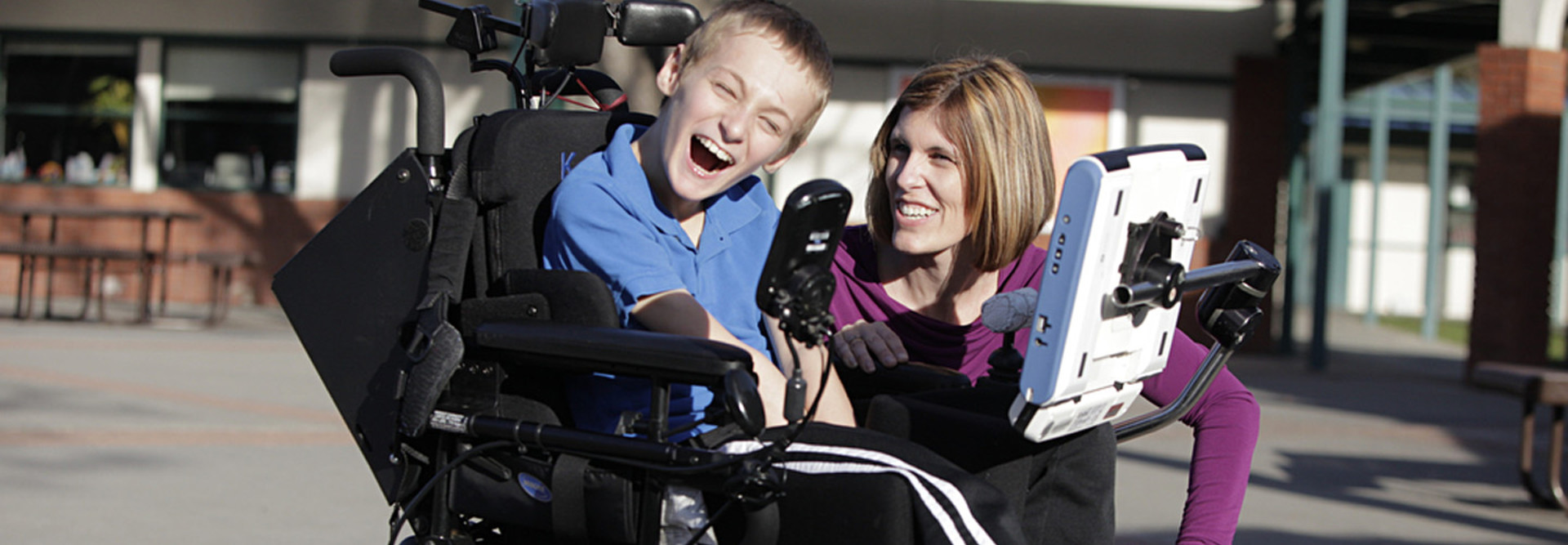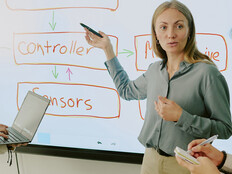How Technology Is Helping Special-Needs Students Excel
For Kevin O'Brien, a seventh-grader with physical disabilities who attends Charlotte Wood Middle School in Danville, Calif., there's a definite difference between good and great when it comes to assistive technology. For years, he used a desktop version of Tobii Technology's eye-gaze device, which allowed him to type papers, participate in art classes, conduct online research, communicate with his teacher and do well academically. But it also tethered him to the classroom in which the wired device was located.
So when a wireless version of the product came out last year, Wendy Burkhardt, assistive technology coordinator for the San Ramon Valley Unified School District of which CWMS is a part, immediately got it for O'Brien, who attached it to his wheelchair. Now, she explains, "Kevin can be far more involved in group activities. He can converse with his peers, participate in class discussions, and do his homework, no matter where he is. This has increased his ability to be an independent member of the school and the community."
Successfully educating a special-needs child has always hinged on matching him or her with the best assistive learning device or application available. Fortunately, what's available has expanded and improved by quantum leaps over the past five years as traditional assistive technologies have converged with consumer technologies, giving the district's special education department a "much bigger toolbox to work with," Burkhardt says. "Everything has snowballed because of these innovative technologies."
For example, today's smartphones, tablets and other mobile devices come equipped with universal access functionality, making it possible for users to deploy built-in or easily downloaded assistive technologies. These include speech recognition, screen-reading tools, Braille displays and text-to-speech solutions for the visually impaired; and sound amplifiers, closed-captioning applications and video conferencing technologies that facilitate sign language and lip-reading for the hearing-impaired. Students with motor and mobility disabilities also can use speech recognition tools to turn speech into sharable text, e-books to eliminate page turning and portable eye-gaze devices that are powered by blinks.
Such technologies not only help students better understand concepts and keep up with their peers, they also allow the school to better and more easily integrate special-needs students into general education classes, says Tracy Gray, director of PowerUp What Works, the National Center for Technology Innovation and the Center for Implementing Technology in Education — three programs of the American Institutes for Research that work to improve the educational achievement of students with disabilities.
"The devices available to students with disabilities are no longer these big clunky things on a desk in a separate space away from the classroom," Gray explains. "Students now have access to assistive capabilities on technologies that are smaller, more mobile, more integrated and inexpensive. They're mainstream too, so that makes them cool. All students want to use them."
Opening Up the Classroom
This mainstreaming of assistive technologies is having a significant impact on students — and not just on those who have traditionally required accommodations, says Karen Heilbronner, director of secondary special education for SRVUSD. Among those who benefit most are children with learning disabilities.
"We're no longer limited to helping one particular student with a single specialized technology," Heilbronner says, noting that newer assistive technologies are facilitated by the district's recent investments in upgraded wired and wireless networks and a one-to-one tablet initiative. "These tools are easily extended to any student who needs them."
Those with communication, cognitive, reading, short-term memory or developmental issues are now using tools such as Nuance's Dragon NaturallySpeaking, which reads text back to them; Livescribe Smartpens, which capture everything spoken in class and written by the student; and web-based tools that help students organize their thoughts and assignments.
"We can now give students who have trouble reading every word on a page an e-book reader and text-to-speech capability, and they can sit in class with headphones on, listen to the words as they're read to them and then weigh in on core literature discussions," Burkhardt explains. "In the past, these would have been the students in the back who wouldn't participate, who would have been considered either the shy introvert or the behavioral problem because they weren't able to effectively engage. These tools are really making a difference."
![[title] [title]](/k12/sites/default/files/032813-3-235_0.png)
In fact, many technologies designed for mainstream use can be successfully repurposed to teach students with disabilities. The Montana School for the Deaf & Blind in Great Falls, Mont., for example, relies on interactive whiteboards — a mainstay for most traditional K–12 schools — to better engage its students.
Diane Moog, a teacher in the school's department for the deaf and hard of hearing, says that the technology helps motivate and engage students in the subject they're studying. "For the kids who have difficulty with the whole language concept, what helps solidify vocabulary and language structure is being able to relate to what you're teaching them," she explains. With an interactive whiteboard, "they can touch the screen, see and manipulate visuals illustrating the vocabulary words, move words around to make sentences — it gives them something to which they can attach language."
As her students work at the whiteboard, Moog also requires them to explain what they're doing and why, which not only helps them further develop skills, but also helps her determine their level of understanding. "I can meet their needs a lot better if I know how they're processing what I'm trying to teach them," she says, noting that the whiteboards are currently being evaluated by the school's department for the visually impaired. "If a student is making errors in a math problem, I can see where the process is breaking down for them and then show them what it's supposed to look like and why.
From a Distance
The Washington State School for the Blind also has turned to mainstream technologies to enhance teaching and learning. With help from Microsoft Lync, a unified communications platform that provides video, voice, instant messaging and telepresence, the Vancouver, Wash., school is offering distance instruction in algebra, geometry, pre-calculus and other topics to its 79 students and to special-needs students at other schools.
According to Digital Research and Curriculum Development Coordinator Sherry Hahn, WSSB's technology team initially went in search of a distance learning system as a way to acquire the services of math teacher Robin Lowell, who lives 170 miles away and, for family reasons, couldn't teach in person on campus.
"Math is an extremely difficult subject to teach to a blind or visually impaired student because it is, of course, so visual," Hahn explains. "It takes a unique, experienced teacher to help these students really understand and get the concepts and skills they need to be able to do it independently. Robin is a teacher who can do that, and we wanted to be able to make her available for our students."
After testing and rejecting different variations on basic two-way video and web conferencing, Hahn and her IT team stumbled across Microsoft Lync. Combined with Braille display software, a screen-reading program and a specialized language known as MathSpeak, Lync enables Lowell to see and communicate with her students and to share the different screens on her desktop. "It's like being at a control center," Lowell says. "I can watch all my kids and see their work at the same time."
One of the most incredible features of Lync, Lowell adds, is the ability to instant-message with her students. "It's really a new avenue for kids to be able to reach their teacher in the middle of the lesson without interrupting," she says. "Then, I can seamlessly put questions into my lecture or our discussion without changing topics or disrupting the flow of the class."
Since implementing the solution in 2010, Lowell has been shocked by the academic improvement she's seen. "This technology has been an amazing eye-opener," she says.
Positive Reinforcement
Assistive technologies help special-needs students thrive academically and keep up with their peers. But they’re also helping students achieve additional — sometimes unexpected — rewards.
Educators say that special-needs students who regularly use assistive technologies:
- achieve greater levels of independence;
- gain confidence;
- more willingly reach out to their teachers and peers to ask questions and collaborate;
- self-advocate;
- challenge themselves; and
- seek out new opportunities.








